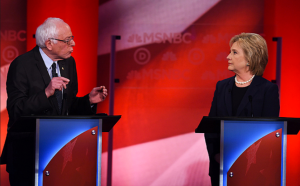 To hear Senator Hillary Clinton’s campaign tell it, you would think that there is absolutely no way to transition from the Affordable Care Act (ACA) world of today to an eventual Medicare-for-All world that her opponent Senator Bernie Sanders promotes.
To hear Senator Hillary Clinton’s campaign tell it, you would think that there is absolutely no way to transition from the Affordable Care Act (ACA) world of today to an eventual Medicare-for-All world that her opponent Senator Bernie Sanders promotes.
The Clinton campaign asserts that the ACA and Medicare-for-All are effectively mutually exclusive. That is, they claim that if you support Medicare-for-All, you must be against the ACA. For instance, former First Daughter Chelsea Clinton was put out on the stump to play Chicken Little:
“Senator Sanders wants to dismantle Obamacare, dismantle the CHIP program, dismantle Medicare, and dismantle private insurance. I worry if we give Republicans Democratic permission to do that, we’ll go back to an era — before we had the Affordable Care Act — that would strip millions and millions and millions of people off their health insurance.”
Chelsea’s mom, a bona fide health care policy expert, knows better. She knows that Senator Sanders proposes to consolidate public insurance programs to make coverage better and more efficient, not eliminate public coverage.
The Clinton campaign’s dire warnings aside, there is a potential middle ground between Senator Sanders’ Medicare-for-All Model and Secretary Clinton’s Stick With The ACA Model. It’s a middle ground that is more politically viable than what Sanders proposes, and more progressive than what Clinton proposes.
The middle ground is this: Amend the Affordable Care Act to allow ACA exchange shoppers the option of voluntarily buying into Medicare.
This middle ground approach would effectively empower patients to decide the fate of Medicare-for-All. Here’s how: If over the years enough ACA exchange shoppers choose of their own free will to buy into Medicare, we will be making progress towards a public single payer system, which in numerous other western countries has proven to be a more effective and efficient model than America’s current model.
On the other hand, if private insurance options prove to be the most attractive, on a quality and/or price basis, the Medicare buy-in option will die off, because it will be exposed as being as inferior as Republicans claim it to be.
But with this Medicare buy-in option, patients would effectively decide Medicare-for-All’s ultimate fate, not politicians. That’s why it’s a middle ground position.
Senator Clinton maintains that a public option lacks sufficient congressional support to pass, and that is certainly a distinct possibility. But if she proves to be correct and it gets defeated, the ACA will still be there. At that point, we would simply stay with the status quo ACA model.
But I’d like to see an aspirational President who was willing to lead a campaign to enact this middle ground approach. Because this would be merely optional for patients, it is much more politically feasible than Sanders’ proposal to mandate Medicare-for-All. Even if a Medicare buy-in option loses, promoting the issue now may pave the way for eventual passage in the future. It moves the national debate forward.
I actually think a passionate, committed President would have an outside shot of passing this. After all, there already is a great deal of support for this approach. GBA Strategies recently asked 1,500 likely 2016 voters whether they supporting giving “all Americans the choice of buying health insurance through Medicare or private insurances, which would provide competition for insurance companies and more options for consumers.”
An overwhelming 71% supported this Medicare buy-in option, including 63% of Republicans and 71% of Independents. Only 13% opposed.
After the special interests start their multi-million distortion and lobbying campaigns, the Medicare buy-in option may well get defeated in a Congress that defeats just about everything. (In fact, any of Senator Clinton’s ideas for incrementally improving the ACA also face a steep uphill battle with a Republican-controlled House). But this survey tells me that there is a solid foundation of support to build on. So why not lead the American people towards this place halfway between Bernie and Hillary, and at least try to make some progress.
Note: This post was featured in MinnPost’s Blog Cabin.
